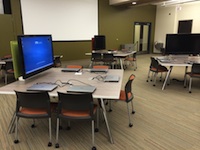U Texas Students, Faculty Get Dedicated Collaboration Space
- By Dian Schaffhauser
- 08/11/14
Instructors, librarians and students at the University of Texas at San Antonio have a new, decked-out classroom dedicated to collaboration. "GroupSpot," as it has been named, sits on the second floor of the main library and is intended to be used by faculty for their courses during the day and by students the rest of the time. The collaborative features of the space are provided by TeamSpot, software from Tidebreak.
|

GroupSpot at UT San Antonio
|
The digital classroom holds:
- 20 tables, each with five laptops and a 46-inch monitor;
- Two retractable projection screens;
- Two wall monitors; and
- Two podiums, each with a laptop.
The room also has 20 additional chairs and can be divided in half for smaller classes.
TeamSpot uses the concept of a "host" desktop or public "worksurface" that is shared and controlled by every user in a group and displayed on the large monitor at each table. Each person can join the group by downloading or running the client software and connecting to the host. That gives him or her the ability to modify what's showing on the big screen with a unique cursor. The team can also share files, Web sites and folders among their individual computers through TeamSpot; once it's moved to the public worksurface, any member of the team can access it.
A session archive records information sent between participants, and can be saved to user computers at the end of the meeting for later retrieval.
TeamSpot also integrates with ClassSpot, another product from the company, which allows an entire classroom of students to share work and collaborate on a large screen.
"GroupSpot changes the learning dynamic and opens up a world of opportunities for innovative teaching practices, including collaborative learning exercises and flipped classroom activities," said Mary Dixson, assistant dean for Faculty Services, in a prepared statement.
Currently, the new space is open for student study whenever the library is open, except for two days during which it is used for other programs. In the fall, the room will be made available to students evenings and weekends, while classes use it during weekdays.
About the Author
Dian Schaffhauser is a former senior contributing editor for 1105 Media's education publications THE Journal, Campus Technology and Spaces4Learning.